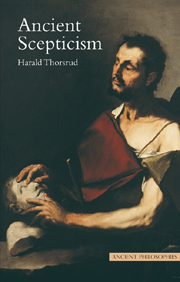Book contents
- Frontmatter
- Contents
- Preface
- Sources and abbreviations
- Chronology
- 1 Introduction
- 2 Pyrrho and Timon: the origin of Pyrrhonian Scepticism
- 3 Arcesilaus: the origin of Academic Scepticism
- 4 Carneades
- 5 Cicero: the end of the sceptical Academy
- 6 Aenesidemus: the Pyrrhonian revival
- 7 Sextus Empiricus: the consistency of Pyrrhonian Scepticism
- 8 Pyrrhonian arguments
- 9 The (ordinary) life of a Pyrrhonist
- Notes
- Guide to further reading
- References
- Index of passages
- Index
3 - Arcesilaus: the origin of Academic Scepticism
- Frontmatter
- Contents
- Preface
- Sources and abbreviations
- Chronology
- 1 Introduction
- 2 Pyrrho and Timon: the origin of Pyrrhonian Scepticism
- 3 Arcesilaus: the origin of Academic Scepticism
- 4 Carneades
- 5 Cicero: the end of the sceptical Academy
- 6 Aenesidemus: the Pyrrhonian revival
- 7 Sextus Empiricus: the consistency of Pyrrhonian Scepticism
- 8 Pyrrhonian arguments
- 9 The (ordinary) life of a Pyrrhonist
- Notes
- Guide to further reading
- References
- Index of passages
- Index
Summary
Some time around 387 bce, Plato began meeting with his students in a grove, or public park, just outside the city wall of Athens, where he had studied philosophy as a young man before becoming a pupil of Socrates (DL 3.5). This particular grove was named aft er a Greek hero, Hekademos. Thus was born Plato's Academy.
Plato also bought (or was given) a private residence nearby where he and his students ate their meals and had the occasional drinking party (symposium). The main philosophical business was conducted both within the private house and in the open space of the park. With the exception of a few anecdotes recorded long aft er the fact, we have no explicit account of the methods and curricula of the original Academy.
However, given the prominent role played by the theory (or theories) of the Forms in Plato's dialogues, and Aristotle's extensive critique in On Ideas (and Met. 1.9), it is likely that they were much discussed in the Academy as well. Plato's first two successors, Speusippus, followed by Xenocrates, both developed elaborate and distinct metaphysical theories apparently designed, like the Forms, to explain the intelligible order in the world (among other things). Since Speusippus and Xenocrates were both members of the Academy prior to Plato's death, the origin of their metaphysical theories is probably to be found in their training with Plato.
- Type
- Chapter
- Information
- Ancient Scepticism , pp. 36 - 58Publisher: Acumen PublishingPrint publication year: 2008

